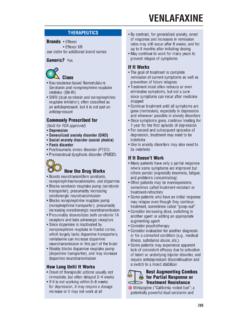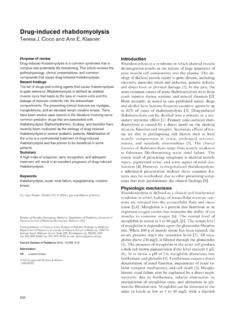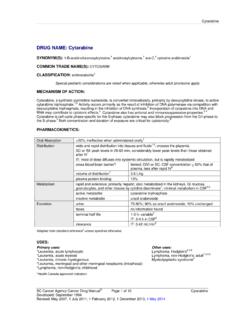Transcription of Drug-Induced EPS, Akathisia, and Tardive Dyskinesia
1 Drug-Induced EPS, akathisia , and Tardive DyskinesiaHandout for the Neuroscience Education Institute (NEI) online activity: Learning Objectives Differentiate antipsychotic treatment options based on risk for Drug-Induced movement disorders Implement updated evidence-based treatment guidelines for managing Drug-Induced movement disorders Explain the mechanisms and clinical data for novel agents under investigation for Drug-Induced movement disordersWhat Are Extrapyramidal Signs (EPS) and Extrapyramidal Side Effects (EPSE)? Movement disorders that occur with antipsychotics Thought to involve structures outside of the pyramidal tract Occur in acute and late ( Tardive )
2 Forms Reason for the older term "neuroleptic" to describe antipsychoticsACUTE AND SUBACUTE EPSEE xtrapyramidal Side Effects Acute extrapyramidal side effects Dystonia Disturbance in muscle tone leading to prolonged contractions of groups of muscles Occurs within 24 48 hours of antipsychotic initiation Only acute EPS that is less common in the elderly Parkinsonism Classic triad of bradykinesia, rigidity, and tremor Occurs within days of treatment in one-fourth to one-third of patients Can occur in up to 75% of older patientsPathophysiology and Treatment Pathophysiology Probably due to D2 blockade in various brain regions Treatment Reduction in dose Anticholinergics and other antiparkinsonians Beta-blockers BenzodiazepinesPretest Question 1A 38-year-old woman was diagnosed with schizophrenia approximately 2 years ago, and after multiple trials of atypical and typical antipsychotic medications.
3 She has been maintained on haloperidol for the last several months with good response. Two weeks ago, she began exhibiting mild motor symptoms of parkinsonism. Which of the following would be the most appropriate adjunct medication for this patient? 1 adrenergic 1 antagonistWhat would be the most appropriate adjunct medication for this patient with EPS?Stahl SM. Stahl's Essential Psychopharmacology. 4th ed. 2013. 11. Alpha 1 adrenergic agonist2. Cholinesterase inhibitorAlpha 1 stimulation may decrease striatal DA release; thus, antagonismwould be expected to reduce EPSR educes metabolism of ACh, causing a further increasein AChactivity3.
4 Histamine 1 antagonistSome antihistamines are M1 antagonists, but their H1 antagonist properties do not regulate EPS4. Muscarinic 1 antagonistPrevents AChfrom binding at M1 receptor and thus reduces its effects, potentially relieving EPSD istribution of Parkinsonian TremorDistribution of Acute DystoniaVideosDystonic Reaction Oculogyric CrisisNeuroleptic- induced Parkinsonism Pill-Rolling TremorNeuroleptic- induced Parkinsonism RigidityParkinson s GaitAKATHISIAA kathisia Overview akathisia is one of the most vexing problems in neuropsychiatry and is still common with second-generation antipsychotics Although it is one of the most common side effects of antipsychotics.
5 It is often difficult to describe by patients and difficult to diagnose and treat by practitioners It is therefore not surprising that akathisia is generally either underdiagnosed or misdiagnosed; this is a serious problem because it can lead to such adverse outcomes as poor adherence to medications, exacerbation of psychiatric symptoms, and in some cases, aggression, violence, and suicideHistory and Pronunciation "Akathisie" coined in 1901 by the Czechoslovakian neuropsychiatrist LadislavHascovec, who created the term in Czech from the Greek (not) + (to be made to sit down) , inability to sit Although the term " akathisia " is often pronounced as rhyming with Dyskinesia (and sometimes even spelled "akathesia")
6 , it derives from very different Greek roots (there is no "kinesis," or movement, in the etymology of akathisia ) It is more correctly spelled " akathisia " and pronounced .k ..si. , where " " is pronounced as in "kit" or "bin" and "i" is pronounced as in "glorious"Phenomenology Straddles the boundary between a symptom (a subjective problem described by a patient) and a sign (an objective problem observed by a clinician) The subjective component can exist independently of the objective component, particularly when the condition is mild; the opposite if there is an objective component but no subjective discomfort has been called pseudoakathisia Although commonly considered a type of movement disorder or EPS, akathisia should be considered more of a sensorimotor disorder because of the powerful sensory component, which is a defining characteristic of the conditionSubjective Symptoms Often extraordinarily difficult for the patient to describe, to some extent because there are few subjective states to which it can be compared Patients often use terms such as "anxiety" or "itching.
7 " although these do not really capture the essence of the condition Since many clinicians have never experienced it, there is often a lack of common ground in communicating the problemPatient Descriptions "It feels like my legs are on fire inside" "It makes me want to run around the room or leap out of my bed" "It's like a deep itching and tingling inside my bones, and moving around relieves it a little" "It's sort of like that feeling you get after your leg falls asleep and then wakes up, but it doesn't go away" "I want to jump out of my skin" Severity of Subjective Problems Severity ranges from "mildly annoying" (and easily relieved by moving a limb or shifting position)
8 , to "absolutely intolerable," associated with extreme dysphoria and a sense of "impending doom" An important cause of medication nonadherence May exacerbate any psychiatric symptoms present, often leading clinicians to inappropriately increase the offending agents, such as SSRIs or antipsychotics Severe cases have been linked to suicidal ideation, aggression, and violenceObjective Signs The objective sign of akathisia is a movement disorder When mild to moderate in severity, the lower extremities are predominantly involved, usually from the hips to the ankles, and the movements take the form of shifting positions while standing and rocking or moving the feet around while sitting With increasing severity, akathisia can involve the entire body, resulting in nearly incessant writhing and rocking movements often accompanied by jumping around, running, and occasionally jumping out of a chair or a bed There are isolated reports of akathisia occurring primarily in other body regions (such as suboccipital muscles)
9 Or in strange distributions, as in hemi- akathisia (affecting only 1 side of the body) Strange or unusual distributions of either subjective or objective components should increase concernthatthere may be another process influencing the clinical presentation, such as an infarction or abscessCharacteristic DistributionVideosAkathisia MildAkathisia SeverePOTENTIAL SUBTYPES OF AKATHISIAA cute, Subacute, and Chronic akathisia Usually occurs within a few days to weeks of initiating or increasing the dose of an antipsychotic During the initial weeks, it is considered acute.
10 Later, it is considered subacute or chronic Chronic akathisia simply refers to akathisia that has been present for a long time, usually for at least several months; it is different from Tardive akathisiaWithdrawal akathisia Phenomenologicallyindistinguishable from acute akathisia Occurs upon antipsychotic dosage decrease or withdrawal Usually appears within 2 weeks of discontinuation and disappears within 6 weeks If it lasts longer, it is probably Tardive akathisiaTardive akathisia Indistinguishable in clinical appearance from acute akathisia , but its time of onset and course resemble those of Tardive Dyskinesia .






